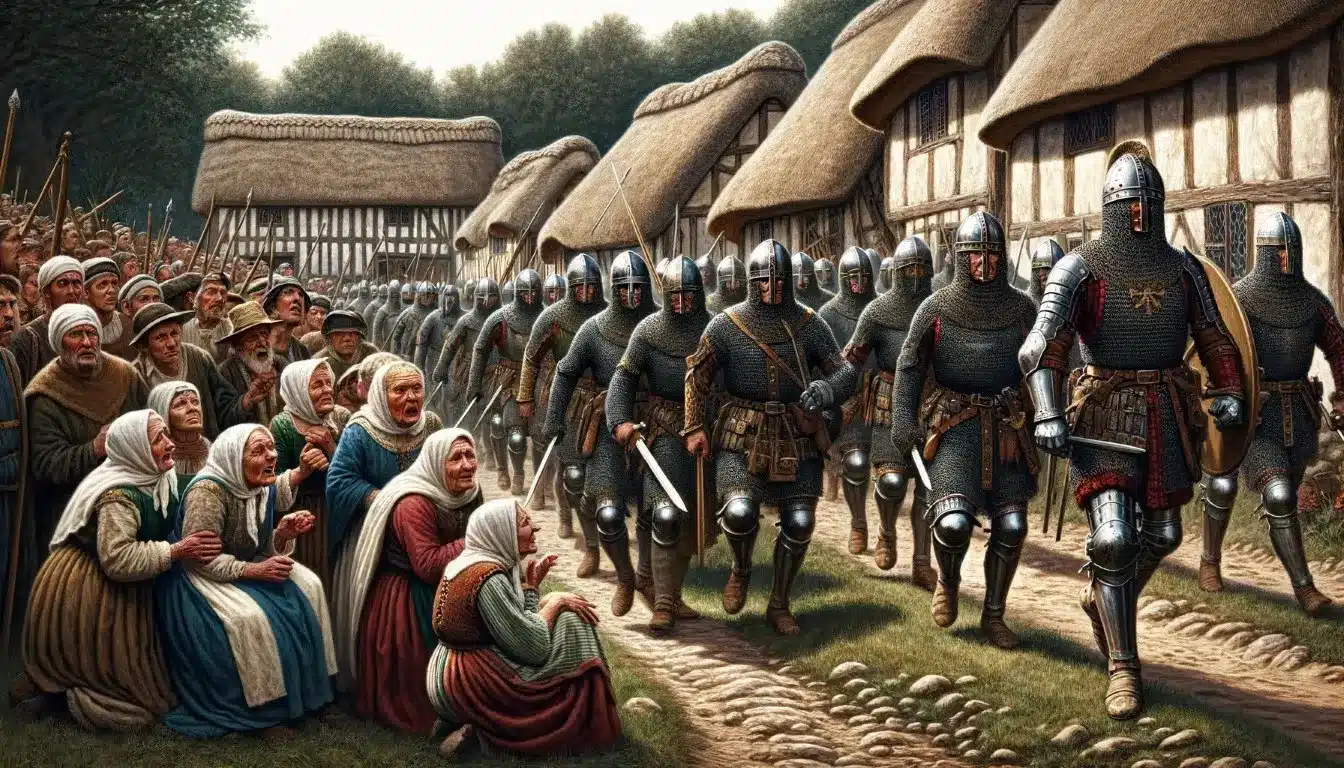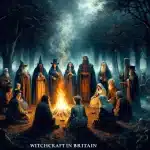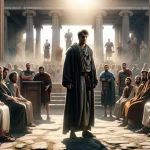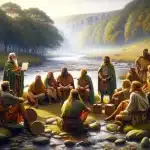Last Updated on 18/02/2024 by Alex Hamlyn
Table of Contents
As we enter the high mediaeval period, for the first time we see the collision of Norman Britain and witchcraft. The Norman view of witchcraft began to seriously influence English thought and culture post the Norman Conquest of 1066. The Normans, originally from what is now Normandy in France, brought with them to England their own cultural and legal traditions, which included attitudes towards witchcraft and the supernatural. Upon their arrival in England, they introduced a new thread into the English social fabric. As a geographic and cultural neighbour, it is reasonable to expect there to have been some influences already, and let us not forget the reason for the Norman invasion in the first place was over a claim to Norman rule over the English lands.
Once full administrative, legal and militaristic rule was established, however, Norman practices and beliefs became the dominant force of the age. This blend was not just limited to administrative, architectural, and linguistic influences but extended into the realm of spiritual and supernatural beliefs as well.
Norman Views on Magic and the Supernatural
Norman beliefs about witchcraft were not as fully developed as they would be later in the mediaeval period. The concept of witchcraft during this time was more aligned with traditional pagan practices and local superstitions rather than the organised, diabolical witchcraft that became the focus of later mediaeval witch hunts. Normans believed in various forms of magic and superstition, but these beliefs were often a blend of their own Norse pagan heritage and Christian elements.
The Norman perspective on magic and the supernatural was rooted in their Norse heritage, which included a belief in a pantheon of gods and mystical beings such as elves, trolls, and spirits. These beliefs coexisted with their Christian faith, leading to a nuanced view of witchcraft. Unlike the later mediaeval period, where witchcraft was often associated with heresy and diabolism, the Normans viewed witchcraft more as a continuation of pre-Christian, pagan traditions.
The Norman conquest also introduced new superstitions and magical practices into England. These included various forms of divination, the use of amulets to ward off evil spirits, and beliefs in the power of certain words and symbols to influence the natural and supernatural world. The integration of these practices with existing English beliefs led to a diversification of the magical and supernatural landscape of England.
This period did not see witchcraft in the malevolent light it would later acquire; instead, magic was often seen as a natural part of the world, capable of both beneficial and harmful effects. People believed in the power of charms, potions, and spells for healing, protection, and sometimes for harm, but these practices were not yet systematically persecuted.
The Evolution of Norman Britain and Witchcraft
During the Norman period, the concept of witchcraft began to evolve, influenced by the cultural exchange between the Normans and the English. This evolution saw a gradual shift from a view of witchcraft as part of traditional pagan practices towards a more structured concept of witchcraft that would emerge in the later mediaeval period. However, in the 11th and 12th centuries, accusations of witchcraft were not yet institutionalised; they remained a part of local disputes and personal vendettas rather than a matter of legal or ecclesiastical concern.
Norman Influence on English Legal Systems
One of the most significant impacts of the Norman Conquest was the introduction of a more centralised legal system. While the early Norman legal codes did not specifically focus on witchcraft, they did lay the groundwork for a more systematic approach to law and order, which later influenced how cases of witchcraft and heresy were handled.
The Norman Conquest of 1066 marked a pivotal turn in the history of English law, introducing a centralised system that replaced the more localised and customary legal practices of the Anglo-Saxons. This transformation under the Normans laid foundational stones for the development of English legal systems, eventually shaping the manner in which law, including cases of witchcraft and heresy, was administered.
Centralization of the Legal System
Prior to the Norman Conquest, English legal practices were largely decentralised, with local lords wielding significant judicial power in their lands. The Normans, led by William the Conqueror, initiated a shift towards centralization, bringing the administration of law under the king’s control. This was a strategic move to consolidate power and establish a uniform system of governance across England.
Introduction of the Feudal System
One of the Normans biggest innovations, which would shape the English world for centuries, was the introduction of the feudal system to England, which restructured society and laid the groundwork for a hierarchical legal system. Under this system, the king was the supreme lord, with vassals (nobles) holding lands from him in exchange for military service. This feudal structure extended down to the peasants, who worked the land. The legal system mirrored this hierarchy, with the king at the apex, establishing a chain of authority that affected how justice was administered.
The Domesday Book and Legal Documentation
One of the most notable contributions of the Normans to the English legal system was the commissioning of the Domesday Book in 1086. This extensive survey documented landholdings, resources, and population across England, serving as a legal and fiscal record. The Domesday Book was a revolutionary tool for its time, enabling a more systematic approach to taxation and legal disputes over land. Its creation signalled the move towards a documented and accountable legal system.
Royal Courts and Itinerant Justices
The Normans established royal courts that centralised legal authority. The king’s court (Curia Regis) evolved into a body that not only advised the monarch but also played a crucial role in administering justice. Moreover, Henry II, William’s descendant, expanded the system by appointing itinerant justices. These judges travelled across the kingdom, holding hearings and trials according to the king’s laws. This practice not only reinforced the king’s authority across England but also helped standardise the application of law.
Influence on Legal Proceedings and Witchcraft Cases
Although early Norman legal reforms did not specifically address witchcraft, the establishment of a centralised legal system created a framework that could later accommodate the prosecution of such cases. As the concept of witchcraft and its association with heresy grew in the later mediaeval period, the centralised legal system facilitated a more uniform approach to these trials. The groundwork laid by the Normans enabled the development of legal procedures and courts that could deal with accusations of witchcraft in a systematic manner.
Church Influence and Witchcraft Accusations
As the Normans strengthened the role of the Church in England, the Church’s views on heresy and pagan practices began to permeate English society. However, the widespread Church-led witch hunts that characterised the later mediaeval period were not yet a feature of the Norman era. Accusations of witchcraft during this time were relatively rare and often tied to accusations of heresy or other forms of social deviance.
It was in the centuries following the Norman Conquest that the concept of witchcraft as a malevolent, diabolical practice began to take shape, influenced by broader European developments.
The Norman Conquest not only changed political and legal landscapes but also initiated significant changes in the religious life of England. The Normans embarked on a program of ecclesiastical reform, aligning the English Church more closely with Roman practices and the broader European Christian community. This reform included the establishment of new monasteries, the building of grand cathedrals, and the appointment of reform-minded clerics to key ecclesiastical positions.
By strengthening the Church’s infrastructure and authority, the Normans inadvertently provided the Church with a platform to exert greater influence over the moral and spiritual lives of the population. This included preaching against pagan practices, which were often conflated with witchcraft in the Christian worldview. The Church’s efforts to Christianize all aspects of life contributed to a gradual shift in how supernatural beliefs were perceived and adjudicated.
Witchcraft, Heresy, and Social Deviance
In the Norman era, accusations of witchcraft were not isolated but were often linked with broader accusations of heresy or social deviance. This reflects a period where the Church was beginning to assert its authority more forcefully, not through widespread witch hunts, but through localised efforts to combat heresy and reinforce Christian orthodoxy. The focus was more on maintaining social order and religious conformity than on rooting out witchcraft specifically.
When the Normans came to England, they mixed their own traditions with those of the Vikings and the English people, creating a fusion of beliefs and ways of doing things. During this time, the Church started to spread its ideas about what was considered wrong or against religion, slowly changing the way people thought and lived. This mix of different cultures and religious ideas set the stage for how people later came to see witchcraft as something evil and connected to dark powers.
Transition Towards a Defined Concept of Witchcraft
The post-Conquest period marked a crucial transition phase in the evolution of witchcraft’s conceptualization. While the Norman influence did not introduce a direct and immediate transformation in witchcraft beliefs, their strengthening of the Church’s role in English society contributed to a slowly changing perception. Over time, as these changes intersected with broader European developments, such as the later mediaeval witch craze, England’s approach to witchcraft began to align more closely with the notion of witchcraft as a serious and diabolical crime.
In summary, while the Norman era did not see the Church-led witch hunts that would characterise later centuries, the period was crucial in setting the stage for these developments. By reinforcing the Church’s power and integrating it more deeply into English society, the Normans contributed to a socio-religious environment in which the seeds of later mediaeval attitudes towards witchcraft and heresy could grow. This era of transition and transformation played a pivotal role in the gradual evolution of beliefs about witchcraft, from a mix of pagan practices and superstitions to a more defined and demonised concept.
Read more in this series
Witchcraft in Britain
An Introduction
Witches in Roman Britain
(1st-5th century)
Viking Britain and Witchcraft
(8th-11th century)
Medieval Britain and Witchcraft
(5th century onward)
Plantagenet and High Medieval Britain (12th-15th century)
17th Century: The Peak of Witch Hunts in Britain
Modern Britain And Witchcraft – As Strange As Ever
Witchcraft and the Celts
(Pre – AD43)
Witches in Saxon Britain
(5th-11th century)
Norman Britain and Witchcraft
(11th-12th century)
Early Modern Period and Restoration (15th-18th century)
Victorian Britain and Witchcraft
(19th-20th century)
Famous Witches in British History
(Plus one Witch Hunter)



